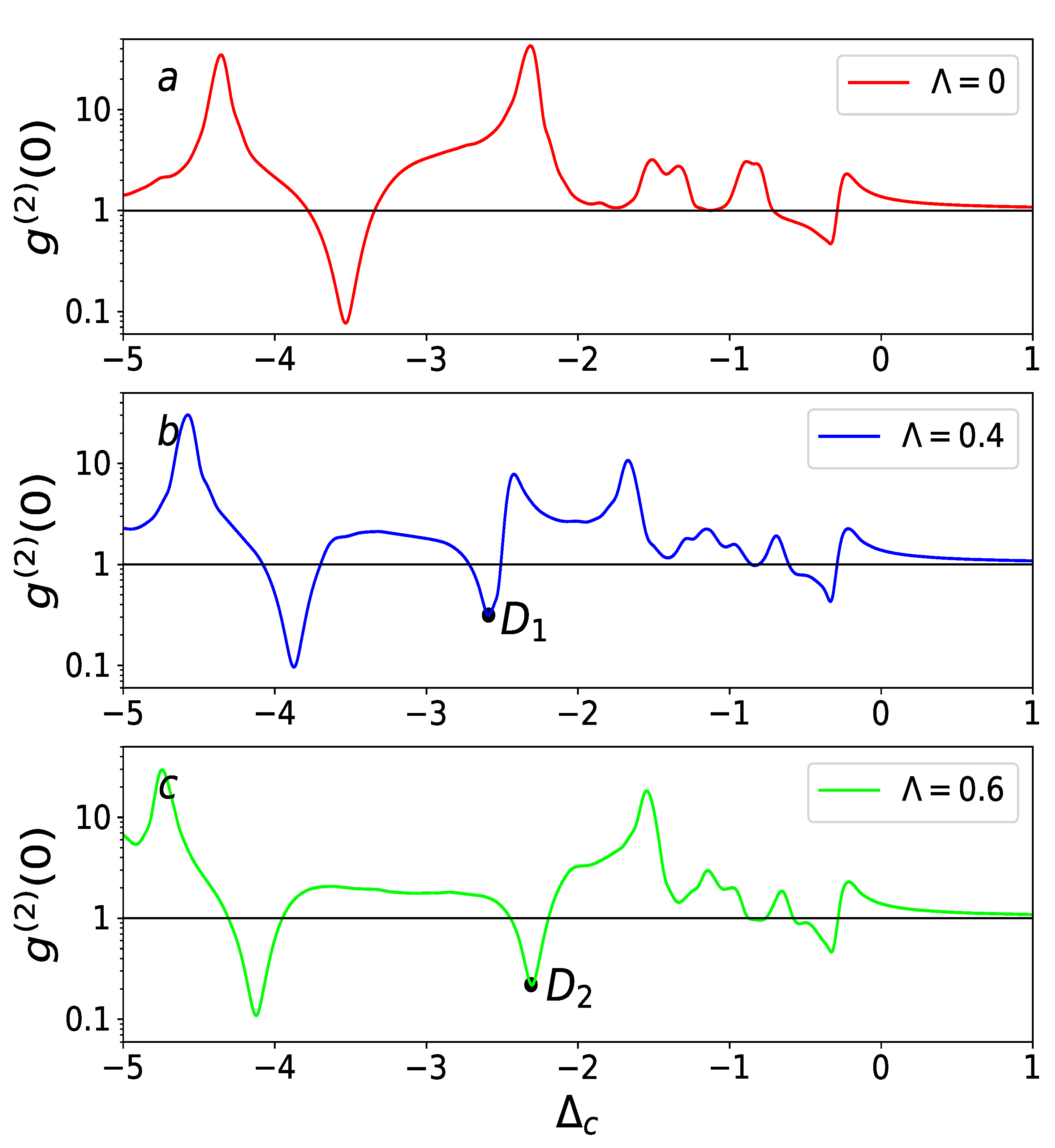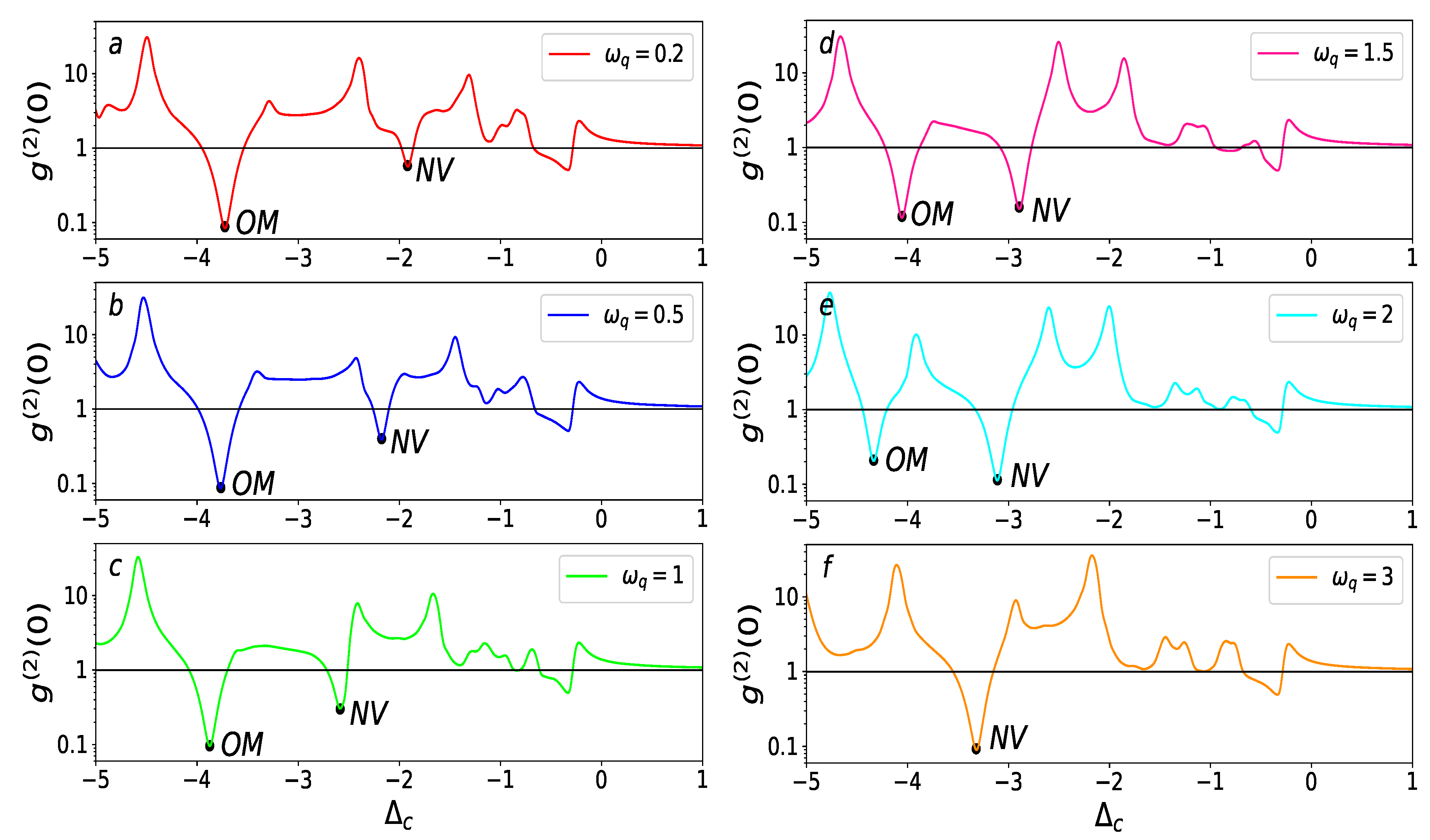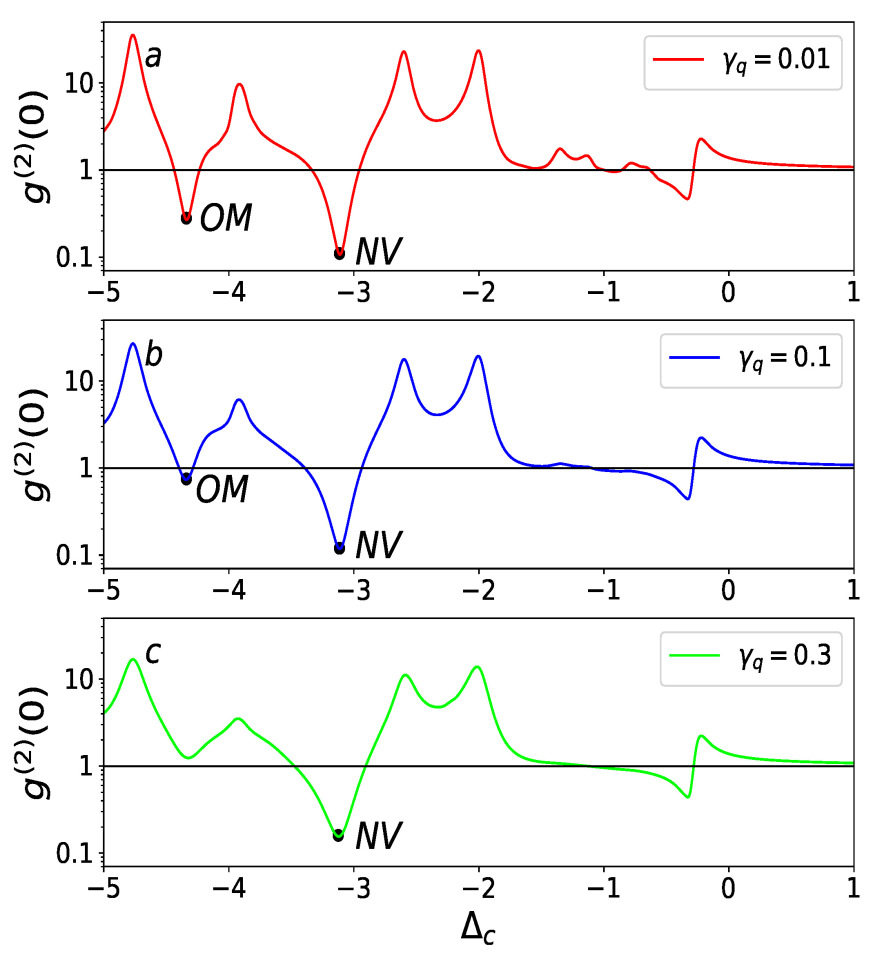The Detection of a Defect in a Dual-Coupling Optomechanical System
Abstract
1. Introduction
2. Physical Model and Solution
2.1. System Hamiltonian

2.2. Energy Structure of the Hybrid System
3. Analytical Solution of the Second-Order Photon Correlation
4. Numerical Solution of the Second-Order Photon Correlation
4.1. Detection of a Defect via the Second-Order Correlation Function
4.2. Amplification of a Defect via Newtonian Gravity
5. Conclusions
Author Contributions
Funding
Data Availability Statement
Conflicts of Interest
Appendix A. The Inner Product of the Equation (48)
References
- Seaton, M.J. Quantum defect theory. In Molecular Applications of Quantum Defect Theory; Routledge: London, UK, 2019; pp. 108–198. [Google Scholar]
- Awschalom, D.D.; Bassett, L.C.; Dzurak, A.S.; Hu, E.L.; Petta, J.R. Quantum spintronics: Engineering and manipulating atom-like spins in semiconductors. Science 2013, 339, 1174–1179. [Google Scholar] [CrossRef] [PubMed]
- Bertoldo, F.; Ali, S.; Manti, S.; Thygesen, K.S. Quantum point defects in 2D materials-the QPOD database. npj Comput. Mater. 2022, 8, 56. [Google Scholar] [CrossRef]
- Gao, W.B.; Imamoglu, A.; Bernien, H.; Hanson, R. Coherent manipulation, measurement and entanglement of individual solid-state spins using optical fields. Nat. Photonics 2015, 9, 363–373. [Google Scholar] [CrossRef]
- Aharonovich, I.; Englund, D.; Toth, M. Solid-state single-photon emitters. Nat. Photonics 2016, 10, 631–641. [Google Scholar] [CrossRef]
- Atatüre, M.; Englund, D.; Vamivakas, N.; Lee, S.-Y.; Wrachtrup, J. Material platforms for spin-based photonic quantum technologies. Nat. Rev. Mater. 2018, 3, 38–51. [Google Scholar] [CrossRef]
- Bassett, L.C.; Alkauskas, A.; Exarhos, A.L.; Fu, K.-M.C. Quantum defects by design. Nanophotonics 2019, 8, 1867–1888. [Google Scholar] [CrossRef]
- Doherty, M.W.; Manson, N.B.; Delaney, P.; Jelezko, F.; Wrachtrup, J.; Hollenberg, L.C. The nitrogen-vacancy colour centre in diamond. Phys. Rep. 2013, 528, 1–45. [Google Scholar] [CrossRef]
- Degen, C.L.; Reinhard, F.; Cappellaro, P. Quantum sensing. Rev. Mod. Phys. 2017, 89, 035002. [Google Scholar] [CrossRef]
- Thiel, L.; Wang, Z.; Tschudin, M.A.; Rohner, D.; Gutiérrez-Lezama, I.; Ubrig, N.; Gibertini, M.; Giannini, E.; Morpurgo, A.F.; Maletinsky, P. Probing magnetism in 2D materials at the nanoscale with single-spin microscopy. Science 2019, 364, 973–976. [Google Scholar] [CrossRef] [PubMed]
- Andersen, T.I.; Dwyer, B.L.; Sanchez-Yamagishi, J.D.; Rodriguez-Nieva, J.F.; Agarwal, K.; Watanabe, K.; Taniguchi, T.; Demler, E.A.; Kim, P.; Park, H.; et al. Electron-phonon instability in graphene revealed by global and local noise probes. Science 2019, 364, 154–157. [Google Scholar] [CrossRef] [PubMed]
- Shi, F.; Zhang, Q.; Wang, P.; Sun, H.; Wang, J.; Rong, X.; Chen, M.; Ju, C.; Reinhard, F.; Chen, H.; et al. Single-protein spin resonance spectroscopy under ambient conditions. Science 2015, 347, 1135–1138. [Google Scholar] [CrossRef] [PubMed]
- Aslam, N.; Pfender, M.; Neumann, P.; Reuter, R.; Zappe, A.; de Oliveira, F.F.; Denisenko, A.; Sumiya, H.; Onoda, S.; Isoya, J.; et al. Nanoscale nuclear magnetic resonance with chemical resolution. Science 2017, 357, 67–71. [Google Scholar] [CrossRef] [PubMed]
- Kucsko, G.; Maurer, P.C.; Yao, N.Y.; Kubo, M.; Noh, H.J.; Lo, P.K.; Park, H.; Lukin, M.D. Nanometre-scale thermometry in a living cell. Nature 2013, 500, 54–58. [Google Scholar] [CrossRef] [PubMed]
- Schirhagl, R.; Chang, K.; Loretz, M.; Degen, C.L. Nitrogen-vacancy centers in diamond: Nanoscale sensors for physics and biology. Annu. Rev. Phys. Chem. 2014, 65, 83–105. [Google Scholar] [CrossRef] [PubMed]
- Barzanjeh, S.; Xuereb, A.; Gröblacher, S.; Paternostro, M.; Regal, C.A.; Weig, E.M. Optomechanics for quantum technologies. Nat. Phys. 2022, 18, 15–24. [Google Scholar] [CrossRef]
- Singh, S.K.; Raymond Ooi, C.H. Quantum correlations of quadratic optomechanical oscillator. J. Opt. Soc. Am. B 2014, 31, 2390–2398. [Google Scholar] [CrossRef]
- McConnell, P.; Houhou, O.; Brunelli, M.; Ferraro, A. Unconditional Wigner-negative mechanical entanglement with linear-and-quadratic optomechanical interactions. Phys. Rev. A 2024, 109, 033508. [Google Scholar] [CrossRef]
- Li, B.B.; Ou, L.; Lei, Y.; Liu, Y.C. Cavity optomechanical sensing. Nanophotonics 2021, 10, 2799–2832. [Google Scholar] [CrossRef]
- Qvarfort, S.; Serafini, A.; Barker, P.F.; Bose, S. Gravimetry through non-linear optomechanics. Nat. Commun. 2018, 9, 3690. [Google Scholar] [CrossRef] [PubMed]
- Kumar, P.; Biswas, T.; Feliz, K.; Kanamoto, R.; Chang, M.-S.; Jha, A.K.; Bhattacharya, M. Cavity optomechanical sensing and manipulation of an atomic persistent current. Phys. Rev. Lett. 2021, 127, 113601. [Google Scholar] [CrossRef] [PubMed]
- Liao, J.Q.; Tian, L. Macroscopic quantum superposition in cavity optomechanics. Phys. Rev. Lett. 2016, 116, 163602. [Google Scholar] [CrossRef] [PubMed]
- Xie, H.; Shang, X.; Liao, C.-G.; Chen, Z.-H.; Lin, X.-M. Macroscopic superposition states of a mechanical oscillator in an optomechanical system with quadratic coupling. Phys. Rev. A 2019, 100, 033803. [Google Scholar] [CrossRef]
- Zhu, B.; Zhang, K.; Zhang, W. Optomechanical preparation of photon number-squeezed states with a pair of thermal reservoirs of opposite temperatures. Photonics Res. 2023, 11, A26–A34. [Google Scholar] [CrossRef]
- Pate, J.M.; Goryachev, M.; Chiao, R.Y.; Sharping, J.E.; Tobar, M.E. Casimir spring and dilution in macroscopic cavity optomechanics. Nat. Phys. 2020, 16, 1117–1122. [Google Scholar] [CrossRef]
- Zhang, W.-Z.; Han, Y.; Xiong, B.; Zhou, L. Optomechanical force sensor in a non-Markovian regime. New J. Phys. 2017, 19, 083022. [Google Scholar] [CrossRef]
- Cosco, F.; Pedernales, J.S.; Plenio, M.B. Enhanced force sensitivity and entanglement in periodically driven optomechanics. Phys. Rev. A 2021, 103, L061501. [Google Scholar] [CrossRef]
- Yan, Z.F.; He, B.; Lin, Q. Force sensing with an optomechanical system at room temperature. Phys. Rev. A 2023, 107, 013529. [Google Scholar] [CrossRef]
- Gavartin, E.; Braive, R.; Sagnes, I.; Arcizet, O.; Beveratos, A.; Kippenberg, T.J.; Robert-Philip, I. Optomechanical coupling in a two-dimensional photonic crystal defect cavity. Phys. Rev. Lett. 2011, 106, 203902. [Google Scholar] [CrossRef] [PubMed]
- He, Q.; Badshah, F.; Zhang, H.; Ali, H.; Basit, A.; Hu, Y.; Ge, G.-Q. Novel transparency, absorption and amplification in a driven optomechanical system with a two-level defect. Laser Phys. Lett. 2019, 16, 035202. [Google Scholar] [CrossRef]
- Ramos, T.; Sudhir, V.; Stannigel, K.; Zoller, P.; Kippenberg, T.J. Nonlinear quantum optomechanics via individual intrinsic two-level defects. Phys. Rev. Lett. 2013, 110, 193602. [Google Scholar] [CrossRef] [PubMed]
- Tignone, E.; Pupillo, G.; Genes, C. Transmissive optomechanical platforms with engineered spatial defects. Phys. Rev. A 2014, 90, 053831. [Google Scholar] [CrossRef]
- Bennett, S.D.; Yao, N.Y.; Otterbach, J.; Zoller, P.; Rabl, P.; Lukin, M.D. Phonon-Induced Spin-Spin Interactions in Diamond Nanostructures: Application to Spin Squeezing. Phys. Rev. Lett. 2013, 110, 156402. [Google Scholar] [CrossRef] [PubMed]
- Lü, X.-Y.; Zheng, L.-L.; Zhu, G.-L.; Wu, Y. Single-Photon-Triggered Quantum Phase Transition. Phys. Rev. Appl. 2018, 9, 064006. [Google Scholar] [CrossRef]
- Lü, X.-Y.; Zhu, G.-L.; Zheng, L.-L.; Wu, Y. Entanglement and quantum superposition induced by a single photon. Phys. Rev. A 2018, 97, 033807. [Google Scholar] [CrossRef]
- Schwab, K.C.; Roukes, M.L. Putting mechanics into quantum mechanics. Phys. Today 2005, 58, 36. [Google Scholar] [CrossRef]
- Arcizet, O.; Jacques, V.; Siria, A.; Poncharal, P.; Vincent, P.; Seidelin, S. A single nitrogen-vacancy defect coupled to a nanomechanical oscillator. Nat. Phys. 2011, 7, 879. [Google Scholar] [CrossRef]
- Teissier, J.; Barfuss, A.; Appel, P.; Neu, E.; Maletinsky, P. Strain Coupling of a Nitrogen-Vacancy Center Spin to a DiamondMechanical Oscillator. Phys. Rev. Lett. 2014, 113, 020503. [Google Scholar] [CrossRef] [PubMed]
- Ian, H.; Liu, Y.; Nori, F. Tunable electromagnetically induced transparency and absorption with dressed superconducting qubits. Physical Review A—Atomic. Mol. Opt. Phys. 2010, 81, 063823. [Google Scholar]
- Hamsen, C.; Tolazzi, K.N.; Wilk, T.; Rempe, G. Two-photon blockade in an atom-driven cavity QED system. Phys. Rev. Lett. 2017, 118, 133604. [Google Scholar] [CrossRef] [PubMed]
- Fan, H.Y.; Li, L.S. Supersymmetric unitary operator for some generalized Jaynes–Cummings models. Commun. Theor. Phys. 1996, 25, 105. [Google Scholar] [CrossRef]
- Bérubé-Lauzière, Y.; Hussin, V.; Nieto, L.M. Annihilation operators and coherent states for the Jaynes-Cummings model. Phys. Rev. A 1994, 50, 1725. [Google Scholar] [CrossRef] [PubMed]
- Johansson, J.R.; Nation, P.D.; Nori, F. QuTiP: An open-source Python framework for the dynamics of open quantum systems. Comput. Phys. Commun. 2012, 183, 1760. [Google Scholar] [CrossRef]
- Johansson, J.R.; Nation, P.D.; Nori, F. QuTiP 2: A Python framework for the dynamics of open quantum systems. Comput. Phys. Commun. 2013, 184, 1234. [Google Scholar] [CrossRef]
- Qvarfort, S.; Plato, A.D.K.; Bruschi, D.E.; Schneiter, F.; Braun, D.; Serafini, A.; Rätzel, D. Optimal estimation of time-dependent gravitational fields with quantum optomechanical systems. Phys. Rev. Res. 2021, 3, 013159. [Google Scholar] [CrossRef]
- Li, Z.; Lu, W.J.; Zuo, Y.L. The manipulation of photon blockade via Newtonian gravity. Sci. Rep. 2024, 14, 13331. [Google Scholar] [CrossRef] [PubMed]




Disclaimer/Publisher’s Note: The statements, opinions and data contained in all publications are solely those of the individual author(s) and contributor(s) and not of MDPI and/or the editor(s). MDPI and/or the editor(s) disclaim responsibility for any injury to people or property resulting from any ideas, methods, instructions or products referred to in the content. |
© 2025 by the authors. Licensee MDPI, Basel, Switzerland. This article is an open access article distributed under the terms and conditions of the Creative Commons Attribution (CC BY) license (https://creativecommons.org/licenses/by/4.0/).
Share and Cite
Li, Z.; Jiao, Y.-F. The Detection of a Defect in a Dual-Coupling Optomechanical System. Symmetry 2025, 17, 1166. https://doi.org/10.3390/sym17071166
Li Z, Jiao Y-F. The Detection of a Defect in a Dual-Coupling Optomechanical System. Symmetry. 2025; 17(7):1166. https://doi.org/10.3390/sym17071166
Chicago/Turabian StyleLi, Zhen, and Ya-Feng Jiao. 2025. "The Detection of a Defect in a Dual-Coupling Optomechanical System" Symmetry 17, no. 7: 1166. https://doi.org/10.3390/sym17071166
APA StyleLi, Z., & Jiao, Y.-F. (2025). The Detection of a Defect in a Dual-Coupling Optomechanical System. Symmetry, 17(7), 1166. https://doi.org/10.3390/sym17071166



